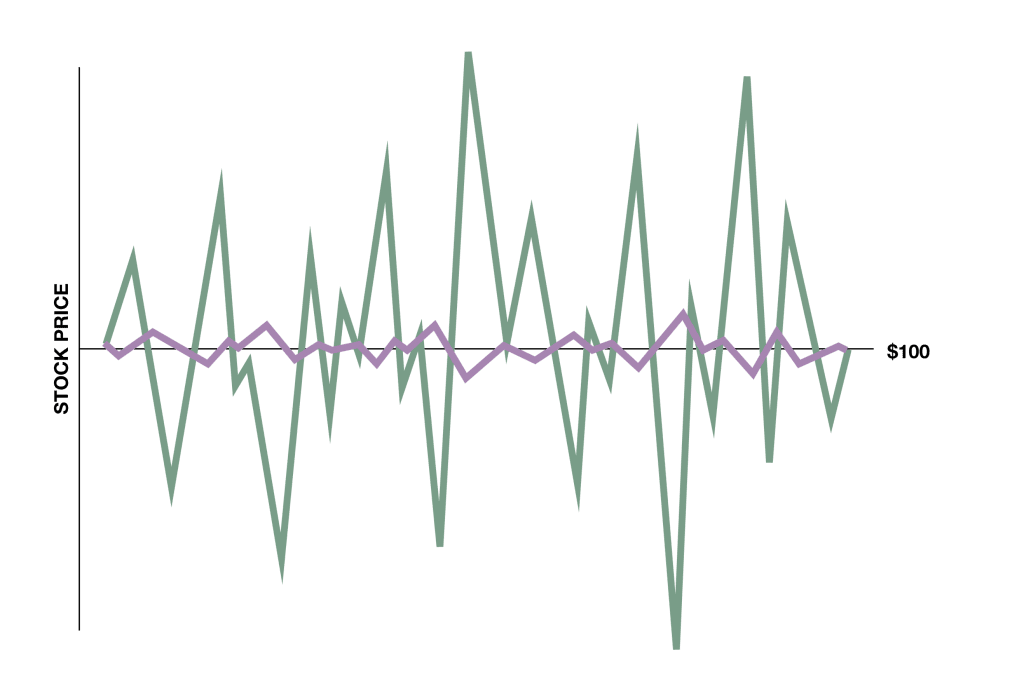When we talk to clients about their investments, there’s a good chance we’re going to talk about volatility. While the word can seem intimidating, volatility as a concept can help you better understand the stock market, your investments, and the way you think about both.
What is volatility?
What do you think of when you hear the word “volatile”? At its essence, a volatile thing feels unstable. You’re never sure which way it will go. We often refer to people, relationships, or political situations as volatile.
The stock market can also be volatile. Volatility in the investing world refers to big moves up and down. A stock, group of stocks, or even the “market” as a whole can go through periods of volatility. On some days, for instance, the S&P 500® might increase 5% in value, then fall 7%. If you just look at the overall move for the day, it may not seem like markets did much at all. But there was a big up and a big down in the interim — it was a volatile day for the S&P 500.
Consider this chart showing the historical volatility of the green stock and the purple stock. Ultimately, they both end up in the same place, but the green stock experienced bigger ups and downs along the way — it was more volatile. In other words, the green stock has high historical volatility compared to the purple stock.

For professional traders, these price swings provide opportunities to make money. But for most investors, they’re a distraction.
Volatility is also relative. For many investors, 2020 and 2021 felt incredibly volatile after years of a historic bull market. In reality, 2020 and 2021 were in line with historical precedent; if anything, they were less volatile than “normal.”
However, a number of high-profile stocks — names like Tesla and GameStop —experienced big swings and contributed to an overall feeling of volatility for stocks.
What do investors need to know about volatility?
Certain assets tend to be more volatile than others. For instance, the slightest news can cause massive moves up or down in a biotech or pharmaceutical stock. Just consider how shares of Pfizer, Moderna, and Johnson & Johnson performed during the development of the COVID-19 vaccines: Any new approval sent prices soaring and any potential side effect or drawback led to steep sell-offs.
Bonds, on the other hand, tend to be less volatile. First, they are issued at a set price, and while that price can fluctuate on secondary markets, the biggest influence on bond prices tends to be interest rates. Since those rates are closely monitored and heavily influenced by Federal Reserve policy, bonds tend to be less volatile.
For investors, the volatility of your holdings matters most if you have a short time horizon. If you expect to need your money soon, a big move up or down can derail your ability to meet your target within your time frame.
How Revo Financial can help you manage volatility
As advisors, we help clients manage volatility in a few ways. First, with the assets we select. We look at your financial goals, your time horizon, your risk tolerance, and more, and select a combination of investments.
For clients with a longer time frame, volatility can tell us more about your tolerance for risk. Big moves up and down in the short term don’t really matter; instead, we’re focused on where your investments are going long-term. However, if big moves in the short term make you uncomfortable, that can help us better understand your investing mindset.
Still, regardless of your time horizon, we want to make sure we’re taking volatility into consideration when managing investments. It’s something we monitor closely. Volatility can come either in short bursts or last for a longer period of time. When the latter happens, we adjust client portfolios to account for it.
The other way — and perhaps the best way — we can help clients manage volatility is by helping you through the ups and downs. Volatility often triggers emotional responses, like a desire to sell an investment if the price drops. But if your favorite store cut prices, you’d want to go shopping. This is where having an impartial advisor making decisions based on data comes in handy.
When big moves happen, we look at the underlying fundamentals of your investments and the economy overall. We also use data, math, and algorithms to guide our decisions, instead of emotion. Often, the volatility making investors nervous is simply par for the course.
That’s the final thing we can offer: Context. A certain amount of volatility is normal. While a 5% sell-off may feel like a very big move on any given day or week, it’s not out of the ordinary when you look at historical context. While volatility often feels like a good or bad thing, most of the time, it’s neither. It’s just a normal part of investing.
